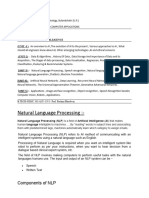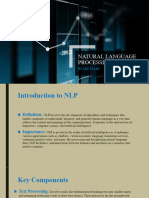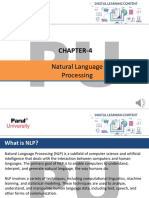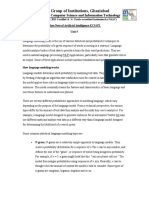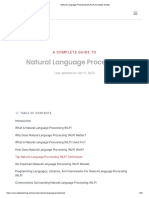Language Model and NLP
Language Model and NLP
Uploaded by
Mohd TahirCopyright:
Available Formats
Language Model and NLP
Language Model and NLP
Uploaded by
Mohd TahirCopyright
Available Formats
Share this document
Did you find this document useful?
Is this content inappropriate?
Copyright:
Available Formats
Language Model and NLP
Language Model and NLP
Uploaded by
Mohd TahirCopyright:
Available Formats
Language Models and Natural Language Processing (NLP) are essential components of
modern artificial intelligence systems that enable machines to understand,
generate, and process human language. Here's an overview of each topic:
1. Language Models:
Language models are computational models that learn patterns and structures in
natural language text. They aim to understand and generate human-like language.
Language models are typically trained on large datasets to learn the statistical
properties of words, phrases, and sentences.
Language models are based on the principle of predicting the next word in a
sequence of words, given the context of the preceding words. They use statistical
techniques, such as n-grams, recurrent neural networks (RNNs), or transformer
architectures, to capture dependencies and generate coherent and meaningful
language.
Modern language models, such as OpenAI's GPT (Generative Pre-trained Transformer)
models, have achieved significant advancements in natural language understanding
and generation. They are trained on vast amounts of text from the internet,
enabling them to generate coherent and contextually relevant responses to a wide
range of queries and prompts.
2. Natural Language Processing (NLP):
Natural Language Processing is a field of study focused on the interaction between
computers and human language. NLP aims to enable machines to understand, analyze,
interpret, and generate human language in a way that is both meaningful and useful.
NLP involves a range of tasks, including:
- Tokenization: Breaking down text into individual words or tokens.
- Part-of-speech (POS) tagging: Assigning grammatical tags to words.
- Named Entity Recognition (NER): Identifying and classifying named entities such
as people, organizations, or locations.
- Sentiment Analysis: Determining the sentiment or emotion expressed in a piece of
text.
- Text Classification: Categorizing text into predefined categories or topics.
- Machine Translation: Translating text from one language to another.
- Question Answering: Answering questions based on a given context or document.
- Text Generation: Generating coherent and contextually relevant text.
NLP techniques involve a combination of rule-based approaches and machine learning
algorithms. Machine learning techniques, including supervised learning,
unsupervised learning, and deep learning, are widely used in NLP to train models on
large datasets and enable them to learn patterns and make accurate predictions.
NLP has numerous real-world applications, such as virtual assistants, chatbots,
sentiment analysis for social media, language translation services, document
summarization, and information retrieval from unstructured text.
Advancements in language models, such as GPT-3 and its variants, have significantly
pushed the boundaries of NLP, enabling more sophisticated language understanding,
text generation, and contextual reasoning.
Both language models and NLP are rapidly evolving fields, with ongoing research and
development driving advancements in natural language understanding and generation.
These technologies play a crucial role in various industries, including healthcare,
customer service, finance, education, and more, where effective human-machine
interaction and communication are essential.
You might also like
- American English File 3 Third Edition Student Book2Document167 pagesAmerican English File 3 Third Edition Student Book2giann.martinez100% (1)
- English Lesson Plan - Class II - Diary Entry - SGO-III BNR - Rahat AghaDocument2 pagesEnglish Lesson Plan - Class II - Diary Entry - SGO-III BNR - Rahat AghaVandana Rawat57% (7)
- Natural Language ProcessingDocument2 pagesNatural Language ProcessingreachudaycNo ratings yet
- AI ASSIGMENT 1 (1) (1)Document4 pagesAI ASSIGMENT 1 (1) (1)kaleemiqra32No ratings yet
- Chapter Proposal Topic: Importance of Natural Language Processing in Cognitive SystemsDocument3 pagesChapter Proposal Topic: Importance of Natural Language Processing in Cognitive Systemssofia guptaNo ratings yet
- Topic 2: Introduction To Natural Language Processing (NLP)Document16 pagesTopic 2: Introduction To Natural Language Processing (NLP)Henok ZelekeNo ratings yet
- NLP Short Que AnsDocument21 pagesNLP Short Que AnsSouvik MondalNo ratings yet
- Lakshmi Priya Vellineni - Module 4 AssignmentDocument5 pagesLakshmi Priya Vellineni - Module 4 AssignmentmodellavinayNo ratings yet
- What Is Natural Language ProcessingDocument3 pagesWhat Is Natural Language ProcessingLelisa SdNo ratings yet
- Unit 3Document14 pagesUnit 3Riya jainNo ratings yet
- Approaches and Methods in Computational LinguisticsDocument18 pagesApproaches and Methods in Computational LinguisticsMaryam AfzalNo ratings yet
- Harmonizing Humanity and TechnologyDocument10 pagesHarmonizing Humanity and TechnologybluecustardpieNo ratings yet
- Natural Language Processing: Bachelor of Technology Computer Science and EngineeringDocument7 pagesNatural Language Processing: Bachelor of Technology Computer Science and EngineeringVarsha ModiNo ratings yet
- NLP Lecture 1Document3 pagesNLP Lecture 1ay4159144No ratings yet
- Chapter-6 Communicating, Perceiving, and ActingDocument10 pagesChapter-6 Communicating, Perceiving, and Actingjunedijoasli100% (1)
- What Is NLP?Document5 pagesWhat Is NLP?Harshit GoyalNo ratings yet
- What Is NLPDocument16 pagesWhat Is NLPAneriMehtaNo ratings yet
- UNIT_5_DLDocument11 pagesUNIT_5_DLssuresh.pecNo ratings yet
- ML Module A7707 - Part1Document48 pagesML Module A7707 - Part1Vijay KumarNo ratings yet
- AI Notes Unit 3Document10 pagesAI Notes Unit 3rashmi.bharadwajNo ratings yet
- NLP IntroductionDocument1 pageNLP IntroductionkrzysiekwieNo ratings yet
- Natural Language ProcessingDocument8 pagesNatural Language Processingzainbarki2233No ratings yet
- NLP Self NotesDocument12 pagesNLP Self NotesKadarla ManasaNo ratings yet
- NLP Module 1Document31 pagesNLP Module 1zishanansari2025No ratings yet
- NLP Module 1Document124 pagesNLP Module 1rayhalcometNo ratings yet
- Natural Language ProcessingDocument16 pagesNatural Language Processingwww.manawalaboo6000No ratings yet
- Basic NLP to End-to-end Pipeline .pptx_removedDocument35 pagesBasic NLP to End-to-end Pipeline .pptx_removedsaikiranpatnana5143No ratings yet
- Neural Networks in Natural Language ProcessingDocument1 pageNeural Networks in Natural Language ProcessingJuan BrattiNo ratings yet
- Exploring the Fascinating World of Natural Language Processing (NLP): Revolutionizing Communication and Empowering Machines through NLP Techniques and ApplicationsFrom EverandExploring the Fascinating World of Natural Language Processing (NLP): Revolutionizing Communication and Empowering Machines through NLP Techniques and ApplicationsNo ratings yet
- Introducing Natural Language ProcessingDocument13 pagesIntroducing Natural Language ProcessingabhishekNo ratings yet
- A Beginner's Introduction To Natural Language Processing (NLP)Document15 pagesA Beginner's Introduction To Natural Language Processing (NLP)Abhishek Morya100% (1)
- Article Format - ShortDocument2 pagesArticle Format - ShortPrasun ChapagainNo ratings yet
- Unleashing The Power of NLP ... Adarsh Pratap SinghDocument2 pagesUnleashing The Power of NLP ... Adarsh Pratap Singhadarsh12643No ratings yet
- NLPDocument11 pagesNLPpjay15017No ratings yet
- Unit 4 NLP NotesDocument35 pagesUnit 4 NLP Notessneha03102003No ratings yet
- AI_certDocument2 pagesAI_certrybkazoceanuNo ratings yet
- P PublicationDocument5 pagesP Publicationarunabadiger01No ratings yet
- What Is Natural Language Processing?Document5 pagesWhat Is Natural Language Processing?Shija MafulahyaNo ratings yet
- Module-1 Introduction To NLPDocument28 pagesModule-1 Introduction To NLPpriyanshuyadav9828No ratings yet
- ML1701 - NLP Notes Unit-1Document38 pagesML1701 - NLP Notes Unit-1shopwithheysellNo ratings yet
- Course Code HUM1012 Logic and Language Structure BL202425040 0921 D21+D22Document55 pagesCourse Code HUM1012 Logic and Language Structure BL202425040 0921 D21+D22Harshit GuptaNo ratings yet
- Natural Language ProcessingDocument3 pagesNatural Language Processingpanha7016No ratings yet
- Chapter 1Document31 pagesChapter 1bhelravisoniNo ratings yet
- UntitledDocument10 pagesUntitledAyush ShindeNo ratings yet
- 1 Natural Language Processing-IntroDocument16 pages1 Natural Language Processing-Introcalm_magicianNo ratings yet
- Arabic Sentiment Analysis and Sarcasm Detection Using Probabilistic Projections-Based Variational Switch TransformerDocument17 pagesArabic Sentiment Analysis and Sarcasm Detection Using Probabilistic Projections-Based Variational Switch Transformerr.python2030No ratings yet
- (IJETA-V11I3P43) :ravi Joshi, Sheikh Mohammed Farhan, Udeshya Sharma, Sahil BhattDocument6 pages(IJETA-V11I3P43) :ravi Joshi, Sheikh Mohammed Farhan, Udeshya Sharma, Sahil BhatteditorijetaNo ratings yet
- NLPDocument17 pagesNLPssp6392215841No ratings yet
- 01 - Intro NLPDocument13 pages01 - Intro NLPKhushi khokharNo ratings yet
- NLP Lect Unit IDocument140 pagesNLP Lect Unit Ishravan3394No ratings yet
- What Is NLP?: Natural Language Processing in AIDocument5 pagesWhat Is NLP?: Natural Language Processing in AIsouravmaity94302No ratings yet
- NLPDocument31 pagesNLPSayli GawdeNo ratings yet
- AIML - Unit4 HPJDocument31 pagesAIML - Unit4 HPJhanishajadwaniNo ratings yet
- Unit 5 - NotesDocument11 pagesUnit 5 - NotesBhavna SharmaNo ratings yet
- Natural Language Processing NotesDocument80 pagesNatural Language Processing NotesShrushti GodseNo ratings yet
- Unlocking-the-Power-of-Natural-Language-Processing-Computational-Linguistics(1)Document15 pagesUnlocking-the-Power-of-Natural-Language-Processing-Computational-Linguistics(1)Maaz SayyedNo ratings yet
- Natural Language Processing (NLP) (A Complete Guide)Document26 pagesNatural Language Processing (NLP) (A Complete Guide)RAPTER GAMINGNo ratings yet
- Project Report on Natural Language ProcessingDocument4 pagesProject Report on Natural Language Processingpradhananubhav295No ratings yet
- What About Natural Processing LanguagesDocument2 pagesWhat About Natural Processing LanguagesSAJIT SAPKOTANo ratings yet
- Introduction To NLPDocument51 pagesIntroduction To NLPKhaldoun AlmomaniNo ratings yet
- NLP for IAF-RS-Final-09-03-2023-newDocument63 pagesNLP for IAF-RS-Final-09-03-2023-newVrushank BhattNo ratings yet
- English Tense-Aspect Forms in TablesDocument54 pagesEnglish Tense-Aspect Forms in TablesКонстантин СмирновNo ratings yet
- CATCH UP PLAN in GRADE IDocument3 pagesCATCH UP PLAN in GRADE IKeith Corpuz LargoNo ratings yet
- Grammar Summary Unit 1Document4 pagesGrammar Summary Unit 1Alison SanchoNo ratings yet
- Research Proposal 1Document14 pagesResearch Proposal 1Een LailaNo ratings yet
- Identifying Verb Phrases: Name: DateDocument2 pagesIdentifying Verb Phrases: Name: DateRuSimbolonNo ratings yet
- Unit 19-20Document10 pagesUnit 19-20Wulan AnggreaniNo ratings yet
- Strategies For Reading Comprehension Read Naturally, IncDocument7 pagesStrategies For Reading Comprehension Read Naturally, IncSARMAD ALINo ratings yet
- Base Form Simple Past Past Participle Meaning: Empower B1 Regular VerbsDocument2 pagesBase Form Simple Past Past Participle Meaning: Empower B1 Regular VerbsEdú RosadoNo ratings yet
- Lesson C: Present Perfect Signal Words: Grammar ActivitiesDocument1 pageLesson C: Present Perfect Signal Words: Grammar ActivitiesMarylin BlancoNo ratings yet
- Geofforey Leech's Model of Meaning SholDocument26 pagesGeofforey Leech's Model of Meaning Sholh95234076No ratings yet
- Importance of OnomatopoeiaDocument17 pagesImportance of OnomatopoeiaYrrem Mita HaniNo ratings yet
- W4.for Ss - Lecture 4.phonemes K14 (Huyen)Document14 pagesW4.for Ss - Lecture 4.phonemes K14 (Huyen)Thu Phương Dương ThịNo ratings yet
- Using The Auxiliary Verb "Be"Document7 pagesUsing The Auxiliary Verb "Be"Siska Elfrida SipahutarNo ratings yet
- OPT B1plus U02 Grammar StandardDocument1 pageOPT B1plus U02 Grammar StandardmelissaNo ratings yet
- Inferring Meaning of Unfamiliar Words Using Context CluesDocument4 pagesInferring Meaning of Unfamiliar Words Using Context CluesKeith Alvin SamsonNo ratings yet
- English Fal P3 GR12 Memo September 2023Document11 pagesEnglish Fal P3 GR12 Memo September 2023shatadimolepiNo ratings yet
- English Consolidated Results Per Adviser Pre Reading and Post Assessment FileDocument2 pagesEnglish Consolidated Results Per Adviser Pre Reading and Post Assessment FileGlenn BiblaniasNo ratings yet
- Pre Finals WikaDocument6 pagesPre Finals Wikaolaine.adonaNo ratings yet
- The First/Second-Mention Rule in Teaching The English ArticleDocument3 pagesThe First/Second-Mention Rule in Teaching The English ArticleKhalil AhmadNo ratings yet
- Remedial Reading ProposalDocument5 pagesRemedial Reading ProposalRodel Bryan Coronejo ValdezNo ratings yet
- Present PerfectDocument2 pagesPresent Perfectcesar barreraNo ratings yet
- Modern Greek For Classicists Reader Grammar en OKDocument459 pagesModern Greek For Classicists Reader Grammar en OKMichael TortorelliNo ratings yet
- Plan Semanal Del 5 Al 9 de JulioDocument3 pagesPlan Semanal Del 5 Al 9 de JulioNery SimmonsNo ratings yet
- Unit 1. No 1Document4 pagesUnit 1. No 1VIETNGUYENNo ratings yet
- Fce Essay GuideDocument5 pagesFce Essay GuideBeccaNo ratings yet
- ENG501 - Grand Quiz - by Maha MalikDocument4 pagesENG501 - Grand Quiz - by Maha Malikmalik100% (1)
- English-10 - WEEK-1 - Budget-of-Work MELCs BasedDocument2 pagesEnglish-10 - WEEK-1 - Budget-of-Work MELCs Basedsherwin_lapenaNo ratings yet
- Form Content and The Inimitability of The Qur N in Abd Al-Q Hir Al-Jurj N S WorksDocument22 pagesForm Content and The Inimitability of The Qur N in Abd Al-Q Hir Al-Jurj N S Works24813No ratings yet



















